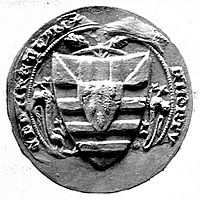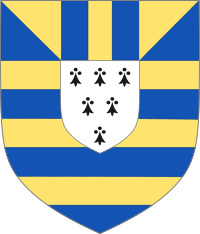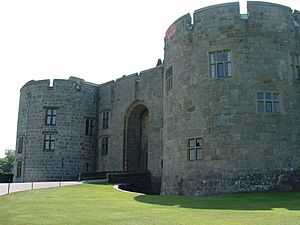Roger Mortimer, 1st Baron Mortimer of Chirk facts for kids
Quick facts for kids
Roger Mortimer
|
|
|---|---|
| Baron Mortimer of Chirk | |
 |
|
| Born | c.1256 |
| Died | 3 August 1326 Tower of London, London |
| Buried | Wigmore Abbey |
| Noble family | Mortimer |
| Spouse(s) | Lucy de la Wafre |
| Issue | Roger Mortimer |
| Father | Roger Mortimer, 1st Baron Mortimer |
| Mother | Maud de Braose |
Roger Mortimer, 1st Baron Mortimer of Chirk (born around 1256 – died August 3, 1326) was an important English lord in the 1300s. He was known for being a powerful "Marcher lord," which meant he controlled lands along the border between England and Wales. Roger Mortimer became famous for standing up against Edward II of England during a conflict known as the Despenser War.
Contents
Roger Mortimer's Early Life and Role
Roger Mortimer was the third son of Roger Mortimer, 1st Baron Mortimer, who was a very strong Marcher lord. His mother, Maud de Braose, Baroness Mortimer, also owned important lands in the border area. The Mortimer family was given their noble status by the king because they were very loyal to the Plantagenet dynasty, the ruling family of England at the time.
Roger married Lucy de la Wavre. They had one son, who was also named Roger. They likely married around 1286.
Land and Power in Wales
In 1269, a Welsh prince named Gruffydd II ap Madog, Lord of Dinas Bran died. His lands were split among his four sons. Later, in 1277, his eldest son, Madog II ap Gruffydd, Lord of Dinas Bran, also died. His two younger brothers, Llywelyn and Owain, were still children. This left their lands open to their older brother, Gruffydd Fychan I.
King Edward Longshanks chose Roger Mortimer to be the guardian of Owain and Llywelyn. However, four years later, the bodies of the two boys were found in a river. Mortimer was accused of their murder. Whether he was guilty or not, Mortimer was given their lands, a region called Swydd y Waun.
In 1282, Welsh princes attacked lands that King Edward had been given. This started the Welsh wars. Roger Mortimer was a skilled soldier and a Captain in the king's army, which won the wars. He and his brother, Edmund Mortimer, 2nd Baron Mortimer of Wigmore, were involved in a plan that led Llywelyn ap Gruffudd, the last native Welsh prince, out of his territory.
Building Chirk Castle
After 1295, Roger Mortimer started building Chirk Castle. It might have been designed by James of St George, who also designed Beaumaris Castle. However, Chirk Castle was not finished when Roger Mortimer died.
Service to the King
Roger Mortimer fought in the Battle of Falkirk in 1298, where the Scottish leader William Wallace was finally defeated. On February 6, 1304, he was given the title Lord of Chirk. The Mortimer family always supported the King's plans in Scotland and on the Welsh borders.
Chirk was loyal to Edward II. He was with the young King when Edward went to arrange his marriage to Isabella of France. They arrived in Dover on January 19, 1308. Roger Mortimer then left Edward to cross the English Channel.
On May 22, 1306, Mortimer was made a knight at Westminster. This important title meant he was of a high enough rank to be an escort to the king.
The Mortimers gained huge amounts of land and took strong control of Welsh areas. Roger was also given control of two castles in North Wales, Blaenyllfori and Dinas. He became so powerful that he was almost like a ruler of Wales himself.
Conflict with Griffith de la Pole
Roger Mortimer prepared to attack Griffith de la Pole, a Welsh nobleman. Griffith was from a powerful Welsh family. His niece, Hawise, was married to John de Charlton. Griffith believed he should inherit land that Hawise had received. He attacked John de Charlton at Welshpool Castle to get his property back. The king did not help settle the dispute legally.
King Edward ordered Chirk to stop the attack on the castle. But Griffith de la Pole refused to let the king settle the matter. John de Cromwell, a royal official, tried to calm Griffith, but Griffith refused his help. Griffith then found support from the Earl of Arundel, another Marcher lord.
Finally, Chirk broke the castle's defenses and captured Griffith. The Earl of Lancaster, who had supported Griffith, had a big argument with Chirk. Lancaster swore that he would always be enemies with the Mortimers. This conflict eventually led to problems for both Chirk and Lancaster.
Roger Mortimer at Bannockburn
In March 1314, King Edward II ordered Chirk to gather 3,000 Welsh soldiers for a war in Scotland. They left Wales on May 27 and marched north. The army gathered at Wark Castle and then Berwick, planning to meet at Stirling Castle. The main army left Berwick on June 17 and reached Edinburgh three days later.
On Sunday, June 23, the leading knights saw Stirling. During the important Battle of Bannockburn on Monday, June 24, Chirk was likely with King Edward's personal guards. They stayed with the King when it seemed like the battle was lost. Chirk might have been part of the group that protected the King as he escaped into the castle.
Roger Mortimer had been part of the Royal Bodyguard since a castle siege in 1300. Some historians believe that Lord Chirk also advised the Welsh archers during the battle.
Politics in York (1314)
Roger Mortimer and his friends gained more power at court. This was confirmed by Parliament in York in November 1314. They joined with other lords to form a "middle party." This group wanted to be an alternative to the Despenser family, who had a lot of influence over the government.
However, the Mortimers made a powerful enemy in Hugh Despenser the Younger. He wanted revenge because Mortimer's grandfather had killed his grandfather in a battle in 1265.
Rebellion of Llewelyn Bren
On January 28, 1316, a group of Welshmen led by Llewelyn Bren attacked royal officials outside Caerphilly Castle. Llewelyn was protesting against a new royal official named Payn de Turberville. Years of hunger and high taxes had pushed Llewelyn to act to protect his people.
The Earl of Hereford and the Mortimers were ordered to gather soldiers to stop the rebellion. A royal army marched north from Bristol to help Caerphilly Castle. Llewelyn surrendered. Just before this, Chirk attended his nephew Edmund's wedding. It is possible that Chirk was also present at the siege of Bristol in July 1316.
Roger Mortimer as Justiciar of Wales
Because of the problems in Wales, the Earl of Lancaster's group had Chirk removed from his job in January 1315. But when peace returned to Wales, Chirk was given his job back as Justiciar of North Wales in October 1316. A Justiciar was a high-ranking royal official who oversaw justice and administration in a region.
By the 1320s, Chirk was the most important member of his family. He was in strong competition with the Despensers, another powerful family. This family was led by Hugh Despenser the Elder and his son Hugh Despenser the Younger. Hugh the Younger was a favorite of King Edward II. The Despensers took many lands and lordships from others in a bold land-grabbing war.
The Despenser War
The Despensers were sent away from England for a time. Queen Isabella, King Edward's wife, wanted to help the King. She led an army to attack Leeds Castle in Kent, which was held by Baron Badlesmere, a friend of Lancaster.
On December 8, 1321, the King arrived in Cirencester. He was joined by the Despensers, who had been allowed to return. They crossed the river at Shrewsbury. Seeing that their situation was hopeless, the Mortimers surrendered in January 1322. Roger Mortimer of Chirk and his nephew were sent to the Tower of London. Other supporters were sent to Wallingford Castle.
Death of Roger Mortimer
Roger Mortimer of Chirk and his nephew, Roger Mortimer, 3rd Baron Mortimer of Wigmore, surrendered to avoid being immediately executed. They were taken to the Tower of London and kept in very difficult conditions. Lord Chirk died in the Tower on August 3, 1326. He was buried in St Augustine's Priory in Bristol.
His nephew, Roger Mortimer, managed to escape from the Tower and fled to France. From there, he joined Queen Isabella in a successful rebellion against King Edward II in 1326. Roger Mortimer of Wigmore eventually finished building Chirk Castle before he died in 1330.
In Stories
Roger Mortimer of Chirk appears as a character in La Louve de France (The She-Wolf of France). This is a novel in Maurice Druon's series of French historical novels called Les Rois maudits (The Accursed Kings). Samson Fainsilber played him in the 1972 French TV series based on the books.



